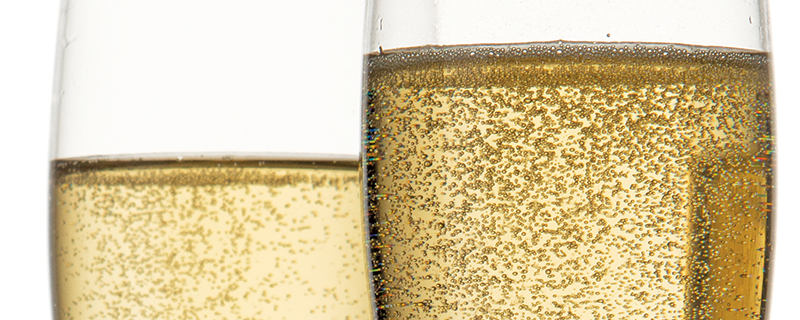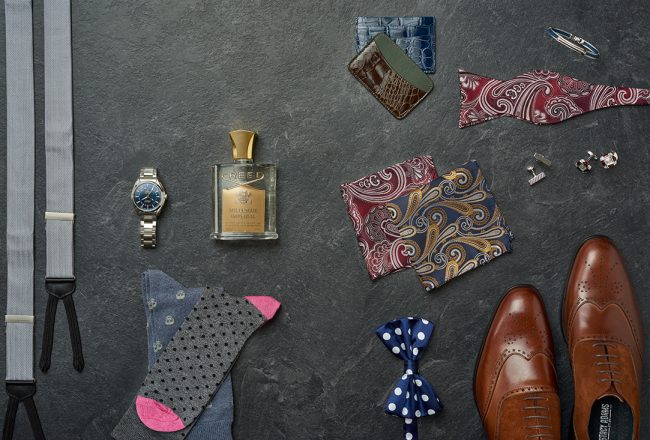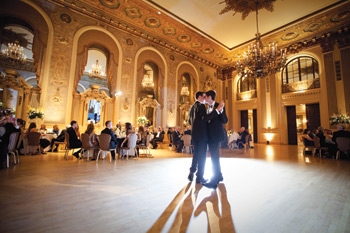Wedding planning tip: Save for the honeymoon.
BY PAM GEORGE
The Real Deal: Champagne
Only sparkling wine from the Champagne wine region in France has rights to the name, according to European Union laws and the law in many countries. Principal grapes grown in this region include Chardonnay, Pinot Noir and Pinot Meunier. In France, wine labeled blanc-de-blanc, refers to 100 percent Chardonnay grapes, says Frank Pagliaro, owner of Frank’s Wine in Wilmington. (In the U.S., blanc de blanc may include a mix of white grapes.)
All wines bubble during fermentation, but the gas escapes during the production. True Champagne undergoes a second fermentation and aging process in the bottle to trap the bubbles. The process, known asméthode champenoise, can take 18 to 40 months or more, says Michael Whitwell, general manager of Premier Wine and Spirits, which has locations in Stanton and Pike Creek.
A Means to an Effervescent End: Sparkling Wine
Méthode champenoise can also be applied to wines made outside the French winemaking region, such as the United States or Australia. (Indeed, many famous French houses have wineries in California, Whitwell notes.) The sparkling wine is made with the same labor-intensive process as wines in Champagne. Because French winemakers insist that even a phrase with the word “Champagne” should only appear on a Champagne label, you may see méthode traditionnelle instead.
A modified method involves a second fermentation in the bottle, after which the wine is transferred to a pressurized tank, where it’s finished and rebottled, Whitwell says. In the charmat, or bulk method, the wine is placed in a tank or large container, where carbon dioxide is trapped to create bubbles. “It’s a very simple and inexpensive way to make sparklers,” he says.
While many sparkling wines are white or rosé, you can add drama with a red, such as a sparkling Shiraz from Australia or a sparkling Brachetto, a sweeter option from Italy.
Say Ciao: Italian Sparkling Wine
As in France, Italy has rules and regulations concerning wines that can be called Prosecco, which is made from the Prosecco grape, grown in the Veneto region.
Asti is produced in Italy’s Piedmont region, particularly around Asti and Alba. Asti is off-dry, fully sparkling and has an alcohol content near 9 percent, while Moscato d’Asti is semi-sweet and softly sparkling, with an alcohol content around 5 to 6 percent.
An Iberian Option: Cava
A Spanish sparkling wine, Cava, by the country’s law, is produced in eight wine regions, including the Basque country and Catalonia. It can be a white or a rosé.
A Matter of Taste
Along with country and method, you can also narrow your choice by the sugar content.
- Extra Brut is very dry wine.
- Brut, which is dry, is the most popular sparkling wine on the market; it’s crisp and good for a toast before a meal or with a meal.
- Extra Dry, despite the name, is not as dry as Brut; it has more sugar.
- Dry or Sec gets sweeter.
- Demi-Sec is so sweet that it’s best with dessert.
Doux has the most sugar of the bunch. Once popular, it’s been eclipsed by Brut wines.
The term “vintage” refers to the harvest year of the grapes used to make the wine. A non-vintage wine has a blend of grapes from multiple years. “This creates a wine or style of wine that is the same every year,” Whitwell says. “It’s common in sparkling wine production.”
Bottom Line
Decide when and how you want to serve the sparkling wine. If you plan to pour in advance and let the sparkling wine sit until the toast, it’s best to buy wine made with the inexpensive charmat method. Save the Veuve Clicquot for the bar. To get the most bang for the buck, Pagliaro suggests Cava or Prosecco, which dollar for dollar can provide more quality than a California sparkling at the same price. “Save the money for the honeymoon,” he says.





No Comment